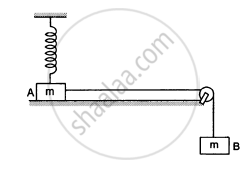Advertisements
Advertisements
Question
A body is falling freely under the action of gravity alone in vacuum. Which of the following quantities remain constant during the fall?
Options
Kinetic energy.
Potential energy.
Total mechanical energy.
Total linear momentum.
Solution
Total mechanical energy.
Explanation:
As the body is falling freely under gravity, the potential energy decreases continuously and kinetic energy increases continuously as all the conservative forces are doing work. So, the total mechanical energy (PE + KE) of the body will be constant.
Let us discuss this in detail:
In the given diagram an object is dropped from-a height H from the ground.
At a point, The total mechanical energy will be EA = K.E + P.E
`E_A = 1/2 mv^2 + mgH`
As velocity will be zero at A, so its kinetic energy will be zero.
`E_A = mgH`
Velocity at point B will be, `v_B = sqrt(2gh)`
So energy at point B will be `E_B = KE + PE`
`E_B = 1/2 m(2gh) + mg(H - h)`
`E_B = mgh + mgH - mgh`
`E_B = mgH`
Now, velocity at point C will be `v_c = sqrt(2gh)`
So, energy at point C will be `E_C = KE + PE`
So, total mechanical energy will remain the same (if we neglect the air friction).
APPEARS IN
RELATED QUESTIONS
A particle is rotated in a vertical circle by connecting it to a string of length l and keeping the other end of the string fixed. The minimum speed of the particle when the string is horizontal for which the particle will complete the circle is
You lift a suitcase from the floor and keep it on a table. The work done by you on the suitcase does not depend on
(a) the path taken by the suitcase
(b) the time taken by you in doing so
(c) the weight of the suitcase
(d) your weight
A block of mass m is attached to two unstretched springs of spring constants k1 and k2 as shown in the following figure. The block is displaced towards the right through a distance x and is released. Find the speed of the block as it passes through the mean position shown.

A small heavy block is attached to the lower end of a light rod of length l which can be rotated about its clamped upper end. What minimum horizontal velocity should the block be given so that it moves in a complete vertical circle?

In the following figure shows two blocks A and B, each of mass of 320 g connected by a light string passing over a smooth light pulley. The horizontal surface on which the block Acan slide is smooth. Block A is attached to a spring of spring constant 40 N/m whose other end is fixed to a support 40 cm above the horizontal surface. Initially, the spring is vertical and unstretched when the system is released to move. Find the velocity of the block A at the instant it breaks off the surface below it. Take g = 10 m/s2.

Figure following shows a light rod of length l rigidly attached to a small heavy block at one end and a hook at the other end. The system is released from rest with the rod in a horizontal position. There is a fixed smooth ring at a depth h below the initial position of the hook and the hook gets into the ring as it reaches there. What should be the minimum value of h so that the block moves in a complete circle about the ring?

A spring of negligible mass and force constant 5 Nm–1 is compressed by a distance x = 5 cm. A block of mass 200 g is free to leave the end of the spring. If the system is released, what will be the speed of the block when it leaves the spring?
A particle is released from height S from the surface of the Earth. At a certain height, its kinetic energy is three times its potential energy. The height from the surface of the earth and the speed of the particle at that instant are respectively ______.
A particle is released from height S from the surface of the Earth. At a certain height, its kinetic energy is three times its potential energy. The height from the surface of the earth and the speed of the particle at that instant are respectively ______
A baloon filled with helium rises against gravity increasing its potential energy. The speed of the baloon also increases as it rises. How do you reconcile this with the law of conservation of mechanical energy? You can neglect viscous drag of air and assume that density of air is constant.
